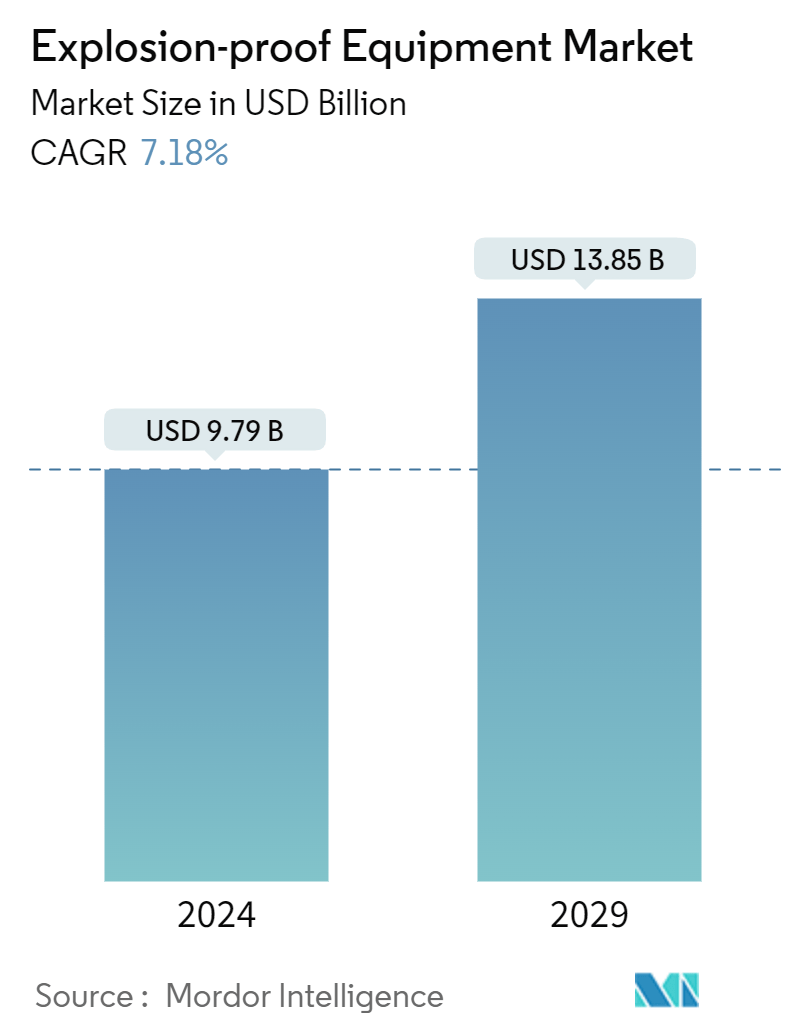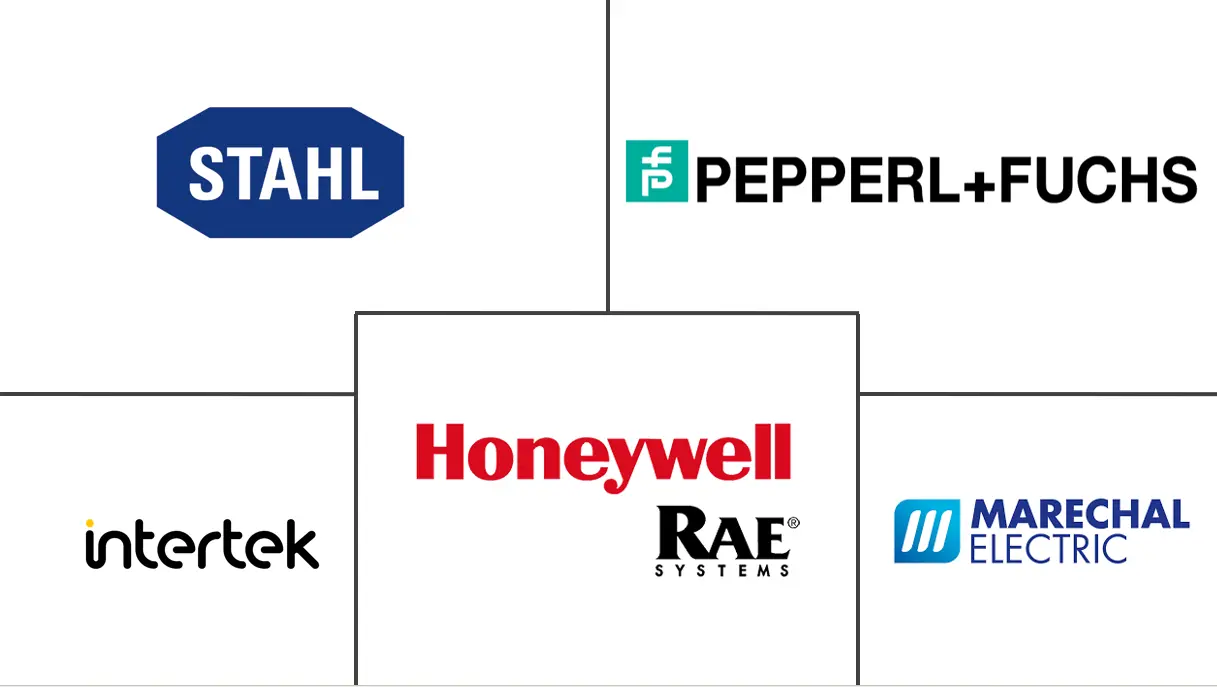Market Size of Explosion Proof Equipment Industry

| Study Period | 2019 - 2029 |
| Market Size (2024) | USD 9.79 Billion |
| Market Size (2029) | USD 13.85 Billion |
| CAGR (2024 - 2029) | 7.18 % |
| Fastest Growing Market | Asia Pacific |
| Largest Market | Asia Pacific |
Major Players
*Disclaimer: Major Players sorted in no particular order |
Explosion Proof Equipment Market Analysis
The Explosion-proof Equipment Market size is estimated at USD 9.79 billion in 2024, and is expected to reach USD 13.85 billion by 2029, growing at a CAGR of 7.18% during the forecast period (2024-2029).
The explosion-proof equipment market is poised to grow owing to the increasing demand for integrated systems, technological advancements in automation, expanding industrial sectors, and stringent government regulations concerning hazardous zones.
- Explosion-proof equipment, both electrical and non-electrical, is engineered to prevent and withstand explosions. This equipment, encased in specialized housing, is designed to withstand specific gas or vapor explosions. As the demand for energy increases, so does the need for secure fuel and energy delivery. Given their critical role in preventing explosions during electricity generation from natural resources, the demand for explosion-proof equipment is rising. With coal remaining essential in global energy production, new coal reserves are being explored.
- Explosion-proof equipment is utilized across various industries, including aerospace, construction, HVAC, manufacturing, mining, and oil extraction. Lighting, surveillance, and signaling equipment are particularly favored in these sectors. Driven by a rise in workplace accidents and mine explosions, regulatory bodies like OSHA are tightening protection protocols to protect workers and the environment. Recognizing the environmental sensitivity of oil and shale reserves, governments are enacting stringent regulations, especially in the oil and gas exploration sector.
- Given their prevalence in capital-intensive sectors like aerospace, manufacturing, and defense, explosion-proof devices command a premium. This results in higher safety device costs for these industries. Additionally, numerous tier 2 and tier 3 manufacturers are producing both single-phase and three-phase explosion-proof AC and DC motors. Low-voltage explosion-proof motors, widely used in the market, find applications in pumps, compressors, and blowers, particularly in the oil and gas sector. The anticipated increase in onshore and offshore oil and gas activities is set to significantly boost the demand for low-voltage motors.
- The absence of standardized laws poses challenges for producers and end-users in designing, testing, and installing explosion-proof equipment. These hurdles, coupled with increased installation costs, are likely to impede the market's growth. The oil and gas, along with the petrochemical sectors, have faced significant challenges due to the COVID-19 pandemic, including a sharp decline in demand, plummeting prices, and storage issues. Notably, the Asia-Pacific region witnessed a sharp decline in oil and gas demand during its lockdown phases, leading to varied impacts on the demand for explosion-proof equipment across different end-user industries.
Explosion Proof Equipment Industry Segmentation
Explosion-proof equipment refers to products that can internally withstand any internal explosion, any sparks generated internally, and prevent these sparks from igniting any vapors, gases, fibers, or dust in the surrounding environment.
The scope of the study focuses on the market analysis segmented by the method of protection (explosion proof, explosion prevention, and explosion segregation), zone (zone 0, zone 20, zone 1, zone 21, zone 2, and zone 22), end user (pharmaceutical, chemical, and petrochemical, energy and power, mining, food processing, oil and gas, other end users), system (power supply system, material handling, motor, automation system, surveillance system, and other systems), and geography (North America, Europe, Asia-Pacific, and rest of the world). The market sizes and forecasts are provided in terms of value in (USD) for all the above segments.
| By Method of Protection | |
| Explosion Proof | |
| Explosion Prevention | |
| Explosion Segregation |
| By Zone | |
| Zone 0 | |
| Zone 20 | |
| Zone 1 | |
| Zone 21 | |
| Zone 2 | |
| Zone 22 |
| By End-user | |
| Pharmaceutical | |
| Chemical and Petrochemical | |
| Energy and Power | |
| Mining | |
| Food Processing | |
| Oil and Gas | |
| Other End Users |
| By System | |
| Power Supply System | |
| Material Handling | |
| Motor | |
| Automation System | |
| Surveillance System | |
| Other Systems |
| By Geography | ||||||
| ||||||
| ||||||
| ||||||
| Rest of the World |
Explosion Proof Equipment Market Size Summary
The explosion-proof equipment market is experiencing robust growth, driven by the increasing demand for safety solutions across various industries such as oil and gas, mining, and chemicals. This growth is fueled by the need for integrated systems and technological advancements in automation, alongside stringent government regulations aimed at ensuring safety in hazardous environments. Explosion-proof equipment, designed to prevent and withstand explosions, plays a critical role in sectors where flammable gases and combustible dust are prevalent. The market is further bolstered by the expansion of industrial sectors in regions like Asia-Pacific, where countries such as India and China are witnessing significant industrialization and regulatory tightening, particularly in the oil and gas and petrochemical industries.
The market's expansion is also supported by the ongoing advancements in explosion-proof technology, with companies investing in innovative solutions to enhance safety and operational efficiency. Notable developments include the introduction of explosion-protected thermometric cameras and explosion-proof smart glasses, which highlight the industry's commitment to safety and technological progress. The demand for explosion-proof equipment is expected to rise as industries continue to prioritize worker safety and regulatory compliance, particularly in capital-intensive sectors like aerospace and defense. Despite challenges such as the absence of standardized laws and increased installation costs, the market is poised for growth, driven by the critical need for safety in high-risk environments.
Explosion Proof Equipment Market Size - Table of Contents
-
1. MARKET INSIGHTS
-
1.1 Market Overview
-
1.2 Industry Value Chain Analysis
-
1.3 Industry Attractiveness - Porter's Five Forces Analysis
-
1.3.1 Threat of New Entrants
-
1.3.2 Bargaining Power of Buyers
-
1.3.3 Bargaining Power of Suppliers
-
1.3.4 Threat of Substitute Products
-
1.3.5 Intensity of Competitive Rivalry
-
-
-
2. MARKET SEGMENTATION
-
2.1 By Method of Protection
-
2.1.1 Explosion Proof
-
2.1.2 Explosion Prevention
-
2.1.3 Explosion Segregation
-
-
2.2 By Zone
-
2.2.1 Zone 0
-
2.2.2 Zone 20
-
2.2.3 Zone 1
-
2.2.4 Zone 21
-
2.2.5 Zone 2
-
2.2.6 Zone 22
-
-
2.3 By End-user
-
2.3.1 Pharmaceutical
-
2.3.2 Chemical and Petrochemical
-
2.3.3 Energy and Power
-
2.3.4 Mining
-
2.3.5 Food Processing
-
2.3.6 Oil and Gas
-
2.3.7 Other End Users
-
-
2.4 By System
-
2.4.1 Power Supply System
-
2.4.2 Material Handling
-
2.4.3 Motor
-
2.4.4 Automation System
-
2.4.5 Surveillance System
-
2.4.6 Other Systems
-
-
2.5 By Geography
-
2.5.1 North America
-
2.5.1.1 United States
-
2.5.1.2 Canada
-
-
2.5.2 Europe
-
2.5.2.1 United Kingdom
-
2.5.2.2 Germany
-
2.5.2.3 France
-
2.5.2.4 Rest of Europe
-
-
2.5.3 Asia-Pacific
-
2.5.3.1 China
-
2.5.3.2 Japan
-
2.5.3.3 India
-
2.5.3.4 Rest of Asia-Pacific
-
-
2.5.4 Rest of the World
-
-
Explosion Proof Equipment Market Size FAQs
How big is the Explosion Proof Equipment Market?
The Explosion Proof Equipment Market size is expected to reach USD 9.79 billion in 2024 and grow at a CAGR of 7.18% to reach USD 13.85 billion by 2029.
What is the current Explosion Proof Equipment Market size?
In 2024, the Explosion Proof Equipment Market size is expected to reach USD 9.79 billion.

